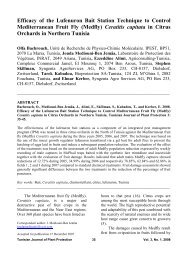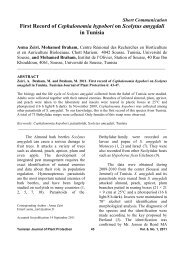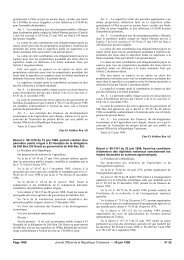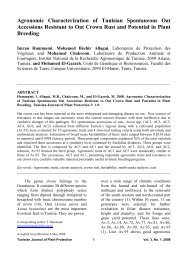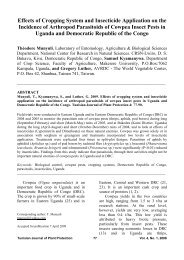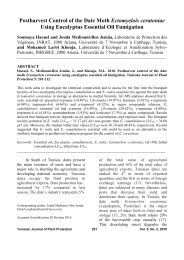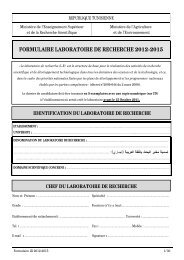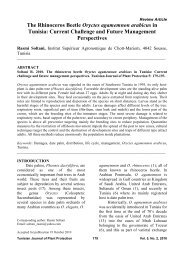Tunisia - Iresa
Tunisia - Iresa
Tunisia - Iresa
You also want an ePaper? Increase the reach of your titles
YUMPU automatically turns print PDFs into web optimized ePapers that Google loves.
ut they are not generally considered as<br />
citrus pests, and there are few reports of<br />
any of these species damaging this crop.<br />
For example, in Southern Italy and in<br />
Cyprus, Frankliniella occidentalis<br />
dominate the thrips fauna of citrus but is<br />
not considered as a pest of citrus (14).<br />
In <strong>Tunisia</strong>, damages attributed to<br />
thrips on several varieties of citrus fruits<br />
have been reported during these last<br />
years. A recent work made in 2008 on<br />
citrus, in the region of Mraïssa (Cap-Bon)<br />
showed the presence of 8 species among<br />
which P. kellyanus which is economically<br />
very harmful on citrus fruits (21).<br />
However, until now, there is not any<br />
measure to control thrips citrus which<br />
were considered as secondary pests. In<br />
contrast, this species causes in Australia<br />
important damages on young and mature<br />
fruits by scurfing (or halo) marking and<br />
rind bleaching that depreciate fruit quality<br />
(4).<br />
P. kellyanus population can be<br />
reduced by insecticide applications (4,<br />
28). Various insecticides were evaluated<br />
in field trials against larval stages I and II.<br />
Among these, the organophosphate<br />
chlorpyrifos, the carbamate methomyl,<br />
and the neonicotinoid acetamiprid were<br />
the most effective (28). However,<br />
repeated chemical treatments can lead to<br />
development of resistance, as it has been<br />
reported to chlorpyrifos in South<br />
Australia, resulting in control failures (3,<br />
24).<br />
In <strong>Tunisia</strong>, works on thrips in<br />
citrus orchards are rare because until the<br />
last years, these pests were considered as<br />
secondary and probably because of the<br />
difficulties to study these minute and<br />
hidden insects. Thus, the objective of this<br />
work is a better knowledge of the species<br />
living in citrus orchards and their status.<br />
Moreover, it aims to determine the most<br />
widespread species in two regions of the<br />
North of <strong>Tunisia</strong>: Cap-Bon and Bizerte,<br />
and especially to confirm the presence of<br />
P. kellyanus. We also tried to estimate the<br />
damages caused by thrips on several<br />
varieties of citrus fruits, in relation with<br />
the frequency of the phytosanitary<br />
treatments.<br />
MATERIALS AND METHODS<br />
Trial sites. Twenty three orchards,<br />
10 of the region of Cap-Bon (localities of<br />
Mraïssa, Menzel Bouzelfa, Goba and<br />
Beni Khalled) and 13 of the region of<br />
Bizerte (localities of Alia, Azib, Ras-<br />
Jebel and Sounine), have been surveyed<br />
from December 2009 to March 2010 to<br />
try to estimate the thrips damage.<br />
Estimation of thrips damage. In<br />
these orchards, with a surface nearly of 1<br />
ha, several varieties have been<br />
considered: Grape-fruit, Orange<br />
(Thomson, Maltaise, Valencia-late,<br />
Double-fine, Navel and Meski),<br />
Clementine (Hermandina, MA3, Kassar)<br />
and Lemon. On all of them, we estimated<br />
at the harvest the proportion of scarred<br />
fruits caused either by thrips or by other<br />
factors; because we noticed that for an<br />
unexperienced person it was difficult to<br />
separate accurately the scarred fruits by<br />
the thrips and those damaged by others<br />
factors. The total number of fruits<br />
examined was about 450 for all the<br />
varieties encountered in the orchard.<br />
Then, we calculated the infestation rate<br />
that is: (Number of scarred fruits × 100) /<br />
Total number of examined fruits. Besides,<br />
an investigation was made about the<br />
treatments applied in the orchards to<br />
relate them to the recorded damages.<br />
Thrips species in citrus<br />
orchards. Thrips were collected in the<br />
orchards where the infestation rate was<br />
the highest in both regions, because we<br />
supposed that the thrips species and<br />
densities would be highest in these<br />
<strong>Tunisia</strong>n Journal of Plant Protection 44 Vol. 7, No. 1, 2012






